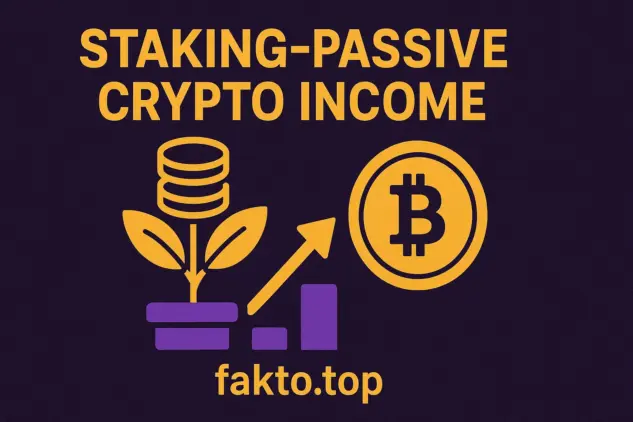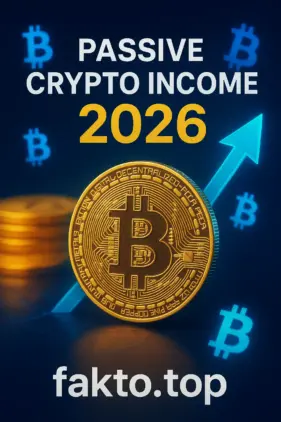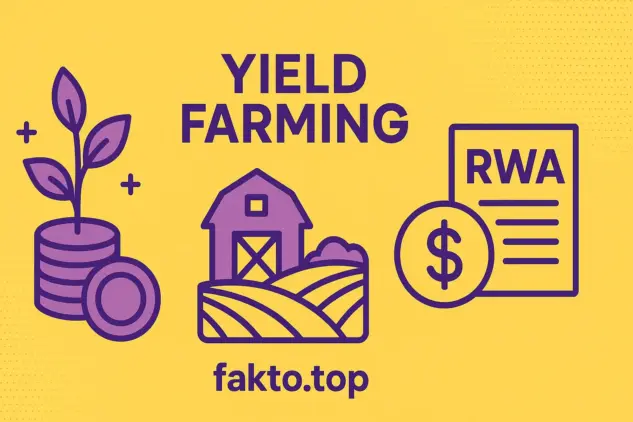Passive Crypto Income 2026: Staking, Yield Farming та RWA Guide
The Ultimate 2026 Guide: Passive Crypto Income Strategies (Yield Farming & Staking)
Passive crypto income strategies in 2026 are no longer a niche experiment for tech-savvy traders. They have evolved into mainstream financial tools that allow everyday investors to generate automated profit through smart contract technology, decentralized platforms, and high-performance staking networks. With institutional liquidity entering the Decentralized Finance (DeFi) ecosystem, capital efficiency and reward structures are now more stable, transparent, and user-friendly.
This guide is designed to be the most complete and practical source for passive income with crypto in 2026. We will break down high ROI staking, the best yield farming platforms, real risk mitigation, impermanent loss explained in human language, and — most importantly — a secure, step-by-step launchpad for beginners. Whether you want a conservative approach using proof-of-stake networks, or a more advanced strategy using liquidity pools, Layer 2 solutions, and restaking — this guide has every actionable detail prepared.

The challenge for newcomers is not opportunity, but complexity. Terms like APY vs APR, liquidity pool tokens, validator commissions, and gas fees optimization create confusion. But when organized properly, staking and yield farming offer predictable, long-term crypto yield with lower risk than speculative trading. Before diving into advanced strategies, let’s start with the core foundation that powers most passive crypto income today — high ROI staking.
Don’t waste capital learning through expensive mistakes.
If you want expert-verified platforms, safer returns, and guidance that prevents common risks in DeFi and yield farming, start with our curated list of trusted services. Save time, avoid scams, and maximize earnings with audited protocols and secure wallets. Your passive crypto income can start today — thousands of investors already do it without coding or trading experience.
I. High ROI Staking: The Low-Risk Engine of Passive Yield
Staking is the backbone of passive crypto income strategies in 2025. Instead of trading tokens or speculating on price swings, staking rewards you for locking your assets in a proof-of-stake (PoS) network. The blockchain uses your tokens to secure transactions, and you earn rewards — usually delivered daily or weekly. This makes staking one of the most reliable and predictable ways to build long-term crypto yield with minimal volatility.
Why High ROI Staking Dominates in 2026
PoS networks matured dramatically. Validator competition lowered fees, security audits increased transparency, and Layer 2 solutions reduced gas costs. In addition, tokenized staking derivatives (LSTs) allow users to earn yield while still using their assets across DeFi lending protocols — generating “double yield”.

Native Staking vs. Liquid Staking (LSTs)
- Native staking: Tokens are locked directly on the network. Simple, long-term, stable yield. Best for beginners and conservative investors.
- Liquid staking tokens (LSTs): Platforms like Lido issue a synthetic token that represents your staked asset. You earn staking rewards and can still use your LST in liquidity pools, lending markets, or yield farming. Higher yield, slightly higher risk.
To evaluate staking platforms, investors compare APR/APY, security audits, slashing risk, and validator reputation. Below is a data-driven comparison of three top platforms dominating 2025.
| Platform | Approx. APY | Risk Level | Security Audit Status |
|---|---|---|---|
| Lido (Ethereum) | 3.5% – 5.0% APY | Low | Audited by CertiK |
| Solana Validators | 6.0% – 7.5% APY | Medium | Audited validator sets, on-chain slashing protection |
| Cosmos Hub (ATOM) | 13% – 16% APY | Medium-High | Independent community audits & governance oversight |
Even though Cosmos offers higher yield, it also includes higher volatility and governance shifts. Ethereum and Solana attract conservative stakers through strong liquidity and long history of uptime. Whichever route you choose, experts recommend using secure DeFi wallets with private key control, rather than centralized exchanges, to eliminate custodial risk.
II. Best Yield Farming Platforms: Strategies for Amplified Crypto Returns
Yield farming became the dominant strategy for investors seeking returns higher than traditional staking. While staking rewards come from securing blockchains, yield farming earns income by supplying liquidity to decentralized exchanges (DEXs) and borrowing/lending protocols. In 2025, the best yield farming platforms combine audited smart contracts, efficient trading mechanisms, and deep liquidity pools. The goal is simple: users deposit two tokens into a Liquidity Pool, earn fees from swaps, and often receive additional token incentives.
The most respected DEX ecosystems for yield farming in 2026 include Uniswap, Curve, and Balancer. Unlike centralized exchanges, these platforms run on automated market makers (AMMs). They do not need order books or market makers — smart contracts handle all trading, pricing, and payouts. Because of their transparency, open-source code, and security audits, these platforms attract billions in locked value.
How LP Tokens Work
When you deposit crypto into a Liquidity Pool, you receive LP tokens. These tokens represent your share of the pool. Your income comes from:

- Trading fees generated every time users swap tokens
- Platform incentives (e.g., governance token rewards)
- Additional farming bonuses on partner protocols
For example, if you supply ETH and USDC to a Uniswap pool, you receive LP tokens. When trades move through that pool, a portion of the transaction fees automatically goes to you. Your LP tokens increase in value as fees accumulate. You can withdraw at any time, reclaiming your original assets plus earnings.
Top Yield Farming Platforms to Know in 2025
1. Uniswap – The most trusted AMM. High liquidity, strong security, major tokens, and deep Layer 2 integrations that reduce gas costs.
2. Curve Finance – Optimized for stablecoins, offering low slippage and reliable returns for conservative yield farmers.
3. Balancer – Known for flexible pool configurations (not just 50/50 pairs). Ideal for advanced strategies with sophisticated DeFi investors.
Investors also rely on Layer 2 networks like Polygon or Arbitrum to reduce gas fees and maximize profit margins. While Ethereum remains the liquidity hub of DeFi, high gas fees can reduce returns. On Layer 2s, farming is cheaper and faster, making small portfolios profitable again.
Security: The Difference Between Profit and Loss
Yield farming platforms only matter if they are secure. Before depositing funds, experienced users review:
- Smart Contract Audits (external firms like CertiK or ChainSecurity)
- Total Value Locked (the more liquidity, the safer against manipulation)
- Time in market (older protocols have stronger reputations)
- Governance transparency and active community
Advanced users also lend LP tokens into DeFi lending protocols, stacking multiple sources of yield. However, more layers mean more risk, and beginners should start with simple pools before experimenting with borrowing or leverage.
III. Crypto Staking vs. Yield Farming: The Decision Matrix
Many newcomers ask the same question: crypto staking vs yield farming — which one is better? The truth is that neither is universally “best.” Instead, each strategy fits different risk profiles, capital sizes, and time horizons. Staking is simpler and safer. Yield farming offers higher returns, but involves liquidity pool volatility and smart contract exposure. The best strategy is to combine both, starting with staking and slowly expanding into farming once you understand how LP tokens behave.
To make the decision clear, the table below compares the two approaches by difficulty, risk, ROI potential, and asset requirements.
| Criteria | Staking | Yield Farming |
|---|---|---|
| Difficulty | Very Low – ideal for beginners | Medium – requires understanding of LP tokens and AMMs |
| Risk Level | Low – minimal volatility, no impermanent loss | Medium to High – price swings and smart contract risks |
| ROI Potential | Stable 3%–15% annually | 10%–100%+ with incentives and compounding |
| Asset Requirement | Single asset (e.g., ETH) | Two tokens for a Liquidity Pool pair (e.g., ETH + USDC) |
If your goal is consistent passive crypto income without active management, staking is the cleanest starting point. If you want higher rewards and are comfortable with DeFi tools, farming can outperform traditional staking by a wide margin.

IV. Risk Mitigation: Impermanent Loss Explained and Avoided
Every profitable DeFi strategy has risks, and yield farming is no exception. The most confusing risk for beginners is impermanent loss. When you deposit two tokens into a Liquidity Pool, the AMM automatically balances the ratio between them. If one token changes price compared to the other, the pool adjusts your holdings. When you withdraw, the number of tokens you receive might be different than the amount you deposited. Even if the total value is higher than before, it may be lower than simply holding both tokens in your wallet — that difference is impermanent loss.
Simple Example
Imagine depositing 1 ETH and 1,500 USDC in a pool when ETH = $1,500. If ETH rises to $2,000, traders will buy ETH from the pool, leaving you with more USDC and less ETH. When you withdraw, your assets still gained value, but you would have earned more by simply holding ETH. Impermanent loss does not always erase profit — but it reduces potential gain.
When Impermanent Loss Hurts the Most
- Highly volatile token pairs
- Unproven altcoins with low liquidity
- Pools offering suspiciously high APY
When Impermanent Loss Is Minimal
- Stablecoin pools (e.g., USDC/USDT on Curve)
- Blue-chip tokens with correlated price movement
- Single-sided liquidity or LST-based pools
How to Avoid Impermanent Loss: Strategy Checklist
- Choose stablecoin pools on audited AMMs like Curve or Uniswap
- Start with balanced, low-volatility pairs
- Use Layer 2 networks (Polygon, Arbitrum) to reduce gas costs
- Track pool performance on trusted analytics dashboards
- Withdraw early if volatility spikes
- Avoid unknown tokens and unaudited farms
Experienced farmers also use official protocol documentation to analyze pool mechanics and fee structures. If a platform lacks transparent smart contract audits from respected security firms like CertiK, capital should not be deposited — no exceptions.
V. The Beginner’s Launchpad: How to Start Yield Farming Safely
Many users searching for passive crypto income strategies 2025 are complete beginners. The good news: you do not need coding skills or trading experience. What you need is security, audited platforms, and a structured checklist. Below is the cleanest step-by-step plan to start yield farming safely, with minimal risk.
Step-by-Step Checklist for Beginners
- Step 1 — Choose a secure DeFi wallet
Before adding funds to any platform, set up a wallet that supports self-custody and hardware integration. For guidance, read this detailed security breakdown on secure DeFi wallets. Never begin yield farming with centralized exchanges — you lose private key control. - Step 2 — Select a low-volatility Liquidity Pool
For your first farming experience, avoid exotic tokens and unstable markets. The safest choice is a stablecoin pair (e.g., USDC/DAI) on audited platforms like Curve Finance. Stablecoins reduce impermanent loss and provide predictable fee income. - Step 3 — Calculate expected APY vs. gas fees
If a pool offers 8% APY but gas fees consume 5%, your real yield is small. Most beginners use Layer 2 networks like Arbitrum or Polygon to optimize gas fees and boost net returns. - Step 4 — Deposit assets and receive LP tokens
Once deposited, the platform automatically mints LP tokens representing your share. These tokens grow in value as the pool earns trading fees. - Step 5 — Monitor performance weekly
Beginners should avoid frequent switching between pools. Weekly checks are enough. If a pool suddenly offers extremely high APY, always verify smart contract audits and official announcements. - Step 6 — Claim and compound rewards
Most platforms let you reinvest your rewards, increasing APY over time. Compounding is where yield farming becomes powerful — small deposits can grow significantly over months of fee accumulation.
Security Rule #1: Never chase unrealistic APY. Extremely high yields often signal new, unaudited contracts or low liquidity, both of which increase risk dramatically.
Security Rule #2: When uncertain, choose audited platforms only. Even professionals avoid “unknown farms” because smart contract exploits can wipe funds instantly.
This conservative launchpad ensures beginners learn farming mechanics while earning real yield without high-risk speculation. Once confident, users can explore advanced strategies — but the foundation must be safe.
VI. Advanced Yield Strategies: Restaking & Tokenized RWAs in 2025
Once you master staking and yield farming basics, the next level of passive crypto income unlocks dramatically higher capital efficiency. In 2025, two advanced strategies dominate expert portfolios:
- Restaking through EigenLayer and Liquid Restaking Tokens (LRTs)
- Tokenized Real World Assets (RWAs) used in DeFi yield markets
Restaking: Earning Yield on Top of Yield
Traditional staking locks tokens for validator rewards. Restaking allows users to “reuse” staked assets to secure additional networks and earn a second layer of income. Rather than holding idle LSTs, restaking platforms put them to work, generating extra returns while the original stake continues earning.
Ethereum is the global leader in restaking thanks to protocols like EigenLayer. For a deeper technical explanation, see Ethereum Restaking Strategies (EigenLayer). The simplified version: you stake ETH, receive a liquid staking token (such as stETH), and then restake that token to secure middleware services. This adds a new reward stream on top of your original yield.
Liquid Restaking Tokens (LRTs)
Platforms like Ether.fi and Renzo introduced LRTs in late 2024. These tokens represent your staked assets and allow reinvestment across multiple protocols. With careful execution, investors can:
- Earn ETH staking rewards
- Earn restaking rewards
- Earn DeFi incentives from farming LRT pairs
However, advanced strategies come with layered risks. Users rely on multiple smart contracts, making security audits and withdrawal guarantees absolutely essential.
Tokenized Real World Assets (RWAs)
The second major upgrade to passive crypto income strategies in 2025 is integration of traditional finance assets. RWAs convert real financial instruments — such as treasury bills, bonds, and commodities — into blockchain tokens that generate real-world yield. These assets often produce stable, predictable income with lower volatility than crypto-native tokens.
Many investors use RWAs as the “safety rail” of their passive income portfolio. For a beginner-friendly guide, visit Tokenized Real World Assets (RWAs) for Crypto Yield. RWA platforms combine off-chain collateral, on-chain tokenization, and monthly yield distributions, making them a strong hedge against crypto price volatility.
Why Experts Love RWA Yield
- Stable yield backed by real assets
- Lower risk of impermanent loss
- No dependency on speculative token emissions
- Better long-term sustainability
Advanced investors often combine staking, restaking, and RWA yield for a balanced portfolio capable of performing in bull and bear markets. While the upside may not be as flashy as meme tokens, the long-term compounding effect is significantly stronger and safer.
VII. FAQ: Your Biggest Questions Answered
Is yield farming still profitable in 2025?
Yes — but only on audited platforms with real trading volume. On trusted DEXs like Uniswap or Curve Finance, fee-based yield remains reliable. High-risk, unaudited farms still exist, but professionals avoid them to prevent smart contract exploits. Profitability in 2025 depends on choosing stable pools, optimizing gas fees, and compounding rewards.
What are the tax implications of staking and farming rewards (USA/EU)?
In both the United States and European Union, staking and yield farming rewards are generally treated as taxable income when received. If assets increase in value after claiming, additional capital gains tax may apply when selling. Because regulations evolve, many investors use crypto tax software or consult licensed professionals to automate reports. Always assume your yield is taxable until proven otherwise.
How to avoid “rug pulls” and smart contract risks?
Avoid anonymous teams, unaudited contracts, and platforms promising unrealistic APY. Always check for external audits from firms like CertiK, review on-chain Total Value Locked, and verify that contracts have existed for months, not days. Smart contract insurance and multi-sig governance are additional safety signals.
How much money do I need to start staking or farming?
Staking can begin with as little as $50–$100 through liquid staking platforms, and yield farming is accessible with similar amounts using stablecoin pools. The key is choosing Layer 2 networks such as Arbitrum or Polygon, where gas fees are low. High yields don’t require big starting capital — they require safe platforms, patience, and compounding.
What is the real difference between APY and APR in DeFi?
APR shows simple yearly interest with no compounding. APY includes compounding — reinvesting rewards generates “interest on interest,” making the real return significantly higher. Yield farmers focus on APY because compounding turns small gains into powerful long-term growth.
Can beginners combine staking and yield farming?
Absolutely. A common beginner strategy is to stake a portion of assets for stable, predictable rewards, while allocating another portion to low-volatility yield farming pools. Over time, as confidence grows, restaking and RWA integration can gradually be added, creating a diversified passive income portfolio.

How often should I claim and reinvest rewards?
For most platforms, weekly or bi-weekly claims are sufficient. Overly frequent transactions can increase gas costs and reduce net APY. Beginners should focus on long-term compounding, allowing small amounts to grow steadily, instead of chasing short-term gains.
Are restaking and tokenized RWAs safe for retail investors?
Yes, when approached with caution. Use only audited platforms, keep exposure moderate, and monitor validator and platform performance regularly. Tokenized RWAs are particularly attractive for risk-averse investors, as they blend DeFi accessibility with real-world asset stability.
Conclusion
Passive crypto income strategies in 2025-2026 offer multiple pathways for investors to generate automated yield. High ROI staking provides stability, yield farming offers amplified returns, and advanced strategies like restaking and tokenized RWAs allow sophisticated portfolio optimization. While risks such as impermanent loss exist, careful selection of audited platforms, low-volatility pools, and Layer 2 optimizations dramatically reduce potential losses.
Investors who combine foundational staking, beginner-friendly yield farming, and gradual exposure to advanced strategies can create a resilient, high-performance passive income portfolio. Leveraging compounding, smart contract audits, and security best practices ensures that your crypto generates sustainable returns year-round.
Take your passive crypto income to the next level.
Start today with expert guidance, trusted platforms, and secure DeFi wallets. Avoid common pitfalls, maximize yield, and build a diversified strategy that works in bull and bear markets alike. Whether staking, yield farming, or exploring tokenized RWAs, our curated resources help you act confidently. Transform your crypto assets into reliable income streams — join thousands of smart investors already leveraging these 2025 strategies.
General Disclaimer
This article is not financial or investment advice. All content is provided for educational and informational purposes only. Cryptocurrencies, Yield Farming, Staking, and other DeFi strategies are high-risk investments and may result in the complete loss of capital. Always conduct your own thorough research (DYOR — Do Your Own Research) and consult with a licensed financial professional before engaging in any investment activity. DeFi protocols, including smart contracts and Restaking platforms, may contain unknown vulnerabilities and are not covered by deposit insurance.
